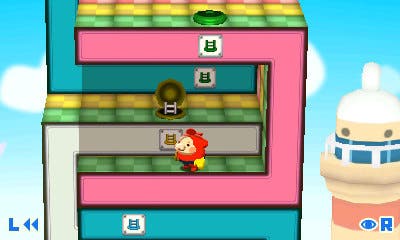Pullblox Review
Chip off the old block.
Nintendo's been on a roll lately with the new entries in its beloved Mario, Zelda, and Mario Kart franchises. Yet even the most dyed-in-the-wool fan will admit concern that the company keeps drawing from the same well. So it should come as a surprise that Nintendo's best first-party original title in years is premiering as a budget release on the 3DS' fledgling eShop.
Pullblox, or Pushmo as it's known in North America, is a puzzle-platformer by Intelligent Systems (WarioWare, Advance Wars, Paper Mario) about rescuing children trapped inside collapsible play structures. While this sounds ridiculously painful, Pullblox doesn't dwell on this silly premise and instead uses it as a simple explanation for why your gnomish red avatar Mallo has to solve a series of spatial challenges.

Scaling these vertical playpens is easier said than done. Each structure is comprised of a series of peculiarly shaped blocks that can be pulled out to three positions along the Z-axis. Blocks can also be grabbed from the side and slid forward, provided there's enough room for Mallo to shuffle his feet. It's a bit like Catherine, without all the sex or frustration. Or sexual frustration.
Astute players will breeze through the first couple hours with ease, but levels grow extraordinarily complex later on. In true Mario fashion, colour-coded pipes act as portals, and switches affect blocks elsewhere. While later stages really test your spatial awareness and outside-the-box thinking (or is it inside the box, in this case?), a series of smart decisions make it more joyful than intimidating.
First off, there's a handy rewind feature that allows you to fix any recent mistakes. If that doesn't do the trick, there's a button on the ground that instantly resets the level to its natural, flat phase. No pausing or reloading necessary. Most stages can be completed quickly once you know what you're doing, so retracing one's steps is less frustrating than it sounds.

This is partially due to polished controls that make mucking about with the transient terrain a pleasure in and of itself. When the once sprightly Mario packed a few pounds in the transition to 3D it felt awkward, but Mallo's steady saunter is perfectly suited for the precarious ledges he must scale. Start to walk off an edge and he'll wobble for a second, giving ample time to react. His jump radius is clearly defined and leaping between the three planes is handled much better than in LittleBigPlanet.
Furthermore, the camera is never an issue. While it's usually tipped down towards Mallo, holding the right trigger sets it parallel to the tower, and you can scroll around with the analogue nub. This is one of the best showcases for the system's 3D, since the whole thing is predicated on shifting blocks towards and away from the camera. Though perfectly suitable with the 3D turned off, this is one of the few titles that resonates much more strongly on the system's unique screen.
In addition to being functionally effective, Pullblox is adorable. Many stages are shaped like cherished childhood obsessions such as dinosaurs, ice cream and cars. Even the 3DS, Game Boy and Mario-themed levels feel less like fan-service or advertising than more things that children - and former children - love.
Despite the low price, Pullblox is rich in content, providing more than many full retail offerings. The campaign's 250 puzzles will keep players busy for ages, and aspiring designers can create their own stages in an intuitive level editor then share them via QR codes.
In many ways, Pullblox is Nintendo's answer to Portal. Both are budget puzzlers released to little fanfare that exhibit the finest qualities of their respective developers. Sliding blocks around may not have the kinetic energy of Mario or the exploratory nature of Zelda, but it maintains the playfulness and intricate craftsmanship that's made other Nintendo series so revered. With news circulating that Shigeru Miyamoto would like to focus on small ideas, one need only look towards Pullblox as a shining example of what the Kyoto-based company can do in the modest-priced digital market.

